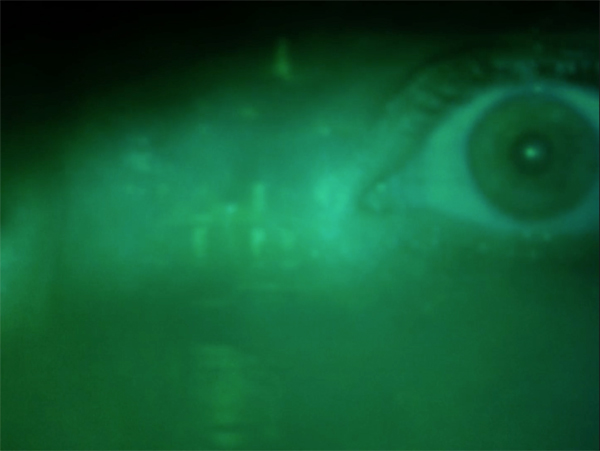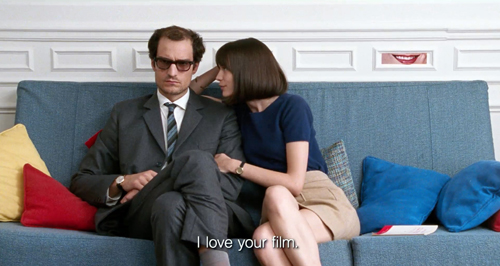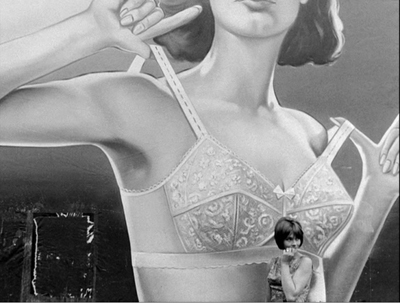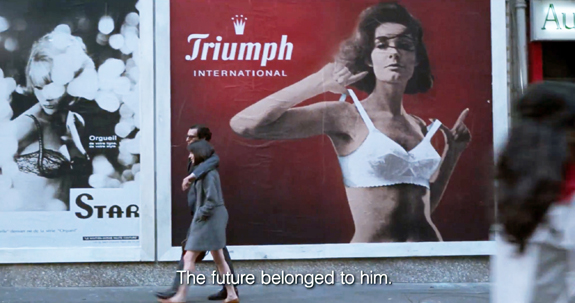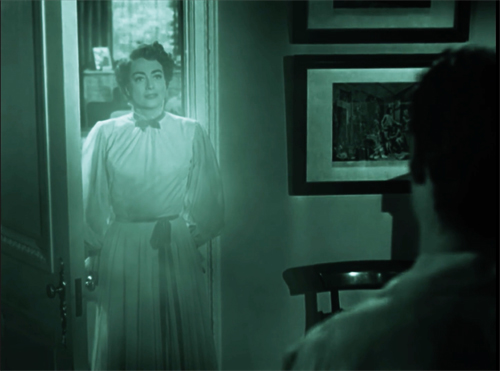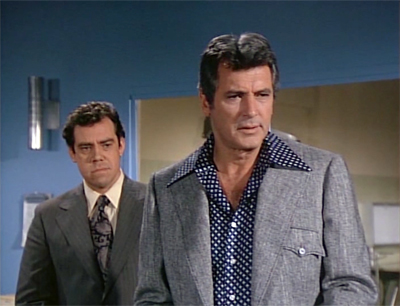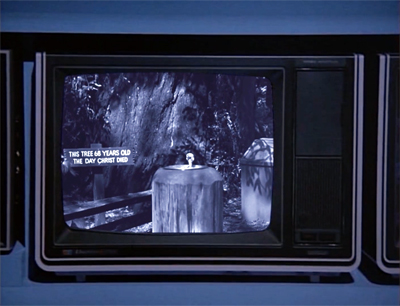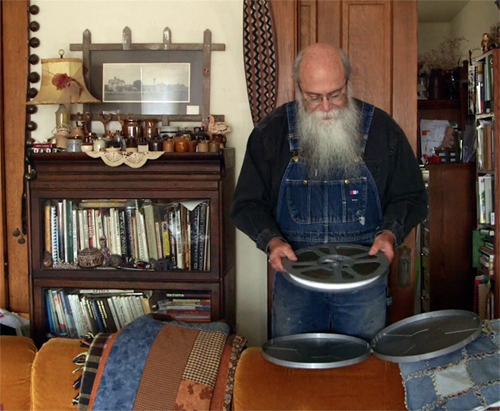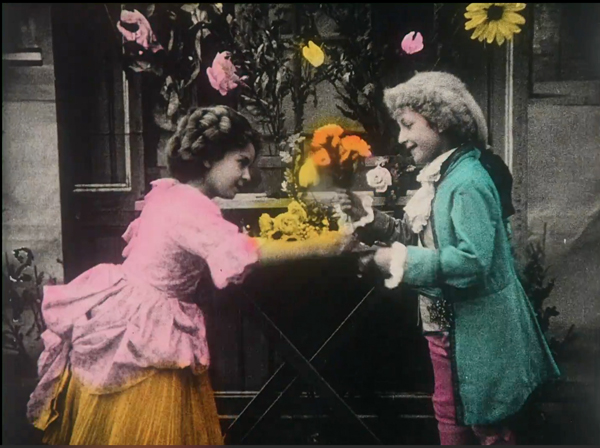The Green Fog (2017).
DB here:
Kristin and I have been unusually busy during this year’s fest, its twentieth [2], so I got to see only ten of the vast array of offerings [3]. Herewith a first report on what our intrepid team–Ben Reiser, Jim Healy, Mike King, Matt St John, and Ella Quainton–programmed and put before adoring crowds. Today we look at movies about movies.
JLG par Not JLG
The title of Michel Hazanavicius’s Le redoubtable has been Francoanglicized as Godard mon amour, not a bad way of signaling it’s a French movie. (The same tactic turned Nikita into La Femme Nikita.) The title also lets us know it centered on the most important living director. And the possessive pronoun correctly puts us in the place of the heroine, the late Anne Wiazemsky, whose memoir-novel chronicled her few years with Godard. How could the film not take her side? On my limited exposure to the man, “difficult” doesn’t begin to describe his temperament.
The film omits Anne’s role in Bresson’s Au hasard Balthasar, which Godard admired extravagantly, and takes us briefly through the shooting of La Chinoise (1967). Soon we’re plunged into ’68 debates about making commercial films, making political films, and “making films politically.” We’re firmly attached to Anne, to the point that Godard’s activities at the Cannes festival are kept obstinately offscreen while we see her sunbathing at a villa. There are unattributed voice-overs from an older male, but mostly we’re in Anne’s consciousness as she struggles to live with the torn, cruel, more or less ridiculous man who brought her into the film industry.
As a satire, the film goes for straightforward targets, such as the moments when people come up to our filmmaker and ask why he doesn’t make movies like Contempt any more. That seems to be Hazanavicius’s question as well. He makes no effort to match his film’s style to Godard’s work in the years when the story takes place. It would have been bold, though probably off-putting, to mimic La Chinoise or Le Gai Savoir (1969), one of his most daring experiments, a sort of Child’s Garden of Semiology. Instead we get snatches of pre-1967 scores, chapter titles, compositions, and iconography, with special emphasis on Une Femme mariée (1964), perhaps a sly reference to Anne’s role.
While pastiching the early work, Hazavanicius softens its edges. One of Godard’s minor innovations, for instance, was inserting a chapter title partway through a new section, rather than planting it at the outset. That not only blurs the boundary between segments and usefully jars the viewer, but it also lets the title give a sharper commentary on the images around it. Tarantino embraced this technique, but Hazanavicius is tidier in his chaptering. Similarly, his shoutouts to planimetric framing don’t really exploit their disruptive possibilities.
His film reminds us that Early Godard has become virtually a period style. Hence, perhaps, Godard’s own flight from it over the last forty years, in the process making films of exceptional beauty and abrasiveness. Still, we tend to forget how unsettling the early films remain. (At the Venice International Film Festival last year, Kristin attended the packed 400-seat screening of the restored Two or Three Things I Know about Her and reported that perhaps a third of the audience had walked out by the end.) Despite all his influence, the original Godard will never become “normalized,” just as Schoenberg will never become elevator music.
Godard mon amour goes down easy and doesn’t, to my way of thinking, have a brain in its pretty head. Godard emerges as a wacky celebrity, politically confused and emotionally bullying. There’s no attempt to show how his personality surfaces in his art, or even why his art is important. Still, Godard mon amour usefully calls attention to a director who, in his 88th year, has another feature coming to Cannes. It’s called Livre de l’image, and it promises to be in five chapters, like the fingers of a hand [7].
Fog over Frisco
Made on commission from the San Francisco International Film Festival [9], The Green Fog is a collage exercise in associational mode, with echoes of Craig Baldwin’s work [10]. In their own gonzo filmfreak way, Guy Maddin and Evan and Galen Johnson have created an homage to the city and its ultimate film, Vertigo.
It can please on many levels. First, there’s the spot-the-clip quiz in the manner of Marclay’s The Clock [11]. Some bits I found fairly easy to identify, but others are drawn from obscure movies and TV programs. All showcase San Francisco. Second, there’s the looping and twisting motifs of male-female tension, surveillance (films projected, phone lines tapped), and class identity: we’re forced to notice how tony restaurants set the stage for 80s big-hair melodrama.
Then there’s the pleasure of watching how cutting can suggest expanding narrative trajectories through eyelines. The Green Fog is an extended exercise in the Kuleshov effect. Sometimes the whole process gets embedded: people watch screens showing people watching people. Or they’re watching a scene from another movie: McMillan, without wife, sees a tree that was 68 years old when Jesus was born.
These linkages are accentuated by the habit of omitting lines of dialogue, so that characters seldom speak but, in shots plagued by visual hiccups, emphatically react to one another, sometimes just by smacking their lips or gulping.
Not least, The Green Fog is a free fantasia on incidents and images from Vertigo. Although only one Vertigo shot is shown, the canonical moments are evoked by their mates in films both earlier and later: people scrambling up buildings and plummeting, couples embracing in horse stables, men pulling women out of the bay, and–thanks to the invading green miasma–a woman stepping out of a doorway to confront her lover. Scotty’s vision of Judy’s aura is made into a city-wide contagion of obsessive love.
The film takes our memories of bits of Hitchcock’s film and spirals out from them, creating a hallucinatory whirlpool of variations on clichés. Going beyond Vertigo, the film evokes its own vertigo, a media phantasmagoria. I was reminded of Geoffrey O’Brien’s book The Phantom Empire.
How did you wander into this maze, anyway, and how would you get out? Do you in fact want to, or do you prefer to sink deeper into it, savoring its manifold ramifications and outlying distortions?
The teeming image-clusters of The Green Fog, made even more eerie and lyrical by Jacob Garchik’s score, capture the delirium of cinephilia, reminding us of how much a masterpiece owes to anonymous, banal visions pulsing through popular culture.
Right here in River City
William Brinton and his wife Indiana were a colorful couple. They were nudists and kept a mummy in their living room. More to our point, around 1900 they ran an Iowa theatre and traveled throughout the midwest showing films and lantern slides. Brinton died in 1919, Indiana in 1955, and the executor of her estate in 1981.
The Brinton collection passed to Michael Zahs–junior-high history teacher and confessed “saver” of things. Three truckloads of boxes came to Zahs labeled “Brinton crap.” They contained over 130 films, 700 magic-lantern slides, many sound recordings, and a host of vintage equipment.
Zahs was told to bury the nitrate materials and dispose of the rest. Instead he hung on to everything, and eventually the American Film Institute and the Library of Congress selected several reels for preservation. Since 1997 16mm copies of Brinton titles have been shown in festivities at the Graham Opera House in Washington, Iowa–a site recently declared by the Guinness Book of World Records to be the world’s oldest surviving film venue. The University of Iowa Library has committed to keeping safety copies of the entire collection.
This fascinating story is brought to light by Tommy Haines and Andrew Sherbourne of Northland Films. Saving Brinton is, like Bill Morrison’s Dalton City: Frozen Time (reviewed by Kristin here [15]), a heroic tale of cinema lost and refound. Morrison’s film centers on 1910s and early 1920s features, but the Brinton legacy [16] takes us back to earlier times. There are “actualities” (newsreels) and gag reels and even–watch Serge Bromberg’s eyes light up–a lost Méliès. Many items are in superb condition, with well-preserved hand-coloring. There are films from Lumière, Edison, and other major companies. In one, a powerful panning shot shows Teddy Roosevelt parading down Market Street in San Francisco (without green fog) just before the earthquake. And then there are the projectors and paper, including a Pathé catalogue.
Saving Brinton is as much a portrait documentary as an account of film rescue. The Brintons stand out, not least for William’s fascination with airships, but the star of the present-day show is Michael Zahs. With his Darwinian beard and jovial presence, he comes across as one of those impresarios who knows a lot about everything, from chemistry to grave marker symbolism [17]. For four years the filmmakers followed his efforts to preserve and show the Brinton legacy, while also tracing his personal life. We get scenes of his devotion to his ailing mother, who died during filming, and interplay with his wife, a smiling woman who doesn’t mind sharing her household with combustible materials. At the same time, this packed documentary evokes the community that welcomed Zahs’ cheerful obsession. As a graduate of the University of Iowa, I had to beam at the sheer niceness radiating from these people and their town and the earth they steward.
On 23 April the University Library in Iowa City will be screening the whole collection, with seven projectors running the films on loops. You can sample them online [18], in pretty copies. And Saving Brinton will continue to tour festivals; you can track its progress here [19]. This charming documentary is a must-see for everybody who loves old movies, not to mention flyover Americana.
My quotation from Geoffrey O’Brien’s The Phantom Empire: Movies in the Mind of the 20th Century [20] (New York: Norton, 1993) comes from p. 28.
The Saving Brinton website [21]gives more information on the film. Diana Nollen’s story in The Gazette [22] supplies helpful background. Watch the trailer [23] and glimpse our old friend Rick Altman [24], emeritus at the University of Iowa.
The Language of Flowers (n.d.).
